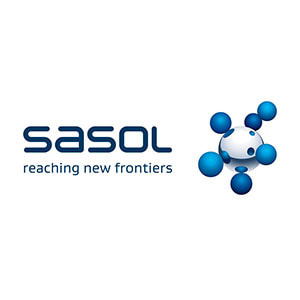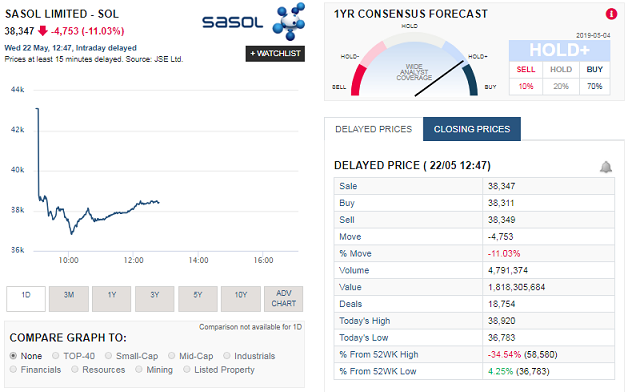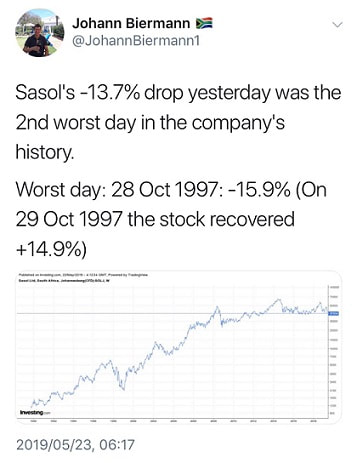|
SASOL's latest Lake Charles update shows their Lake Charles chemicals project (LCCP) will cost at least $1 billion more than previously announced
Category: Stock Market Share Price: R383.47 Date: 22 May 2019 |
Related Topics |
|
In this update we take a look at the latest update from SASOL (SOL) and it discusses their Lake Charles Chemicals Project (LCCP) at length. In February we covered their trading update in which it showed that LCCP will hurt SASOL's earnings as their cost estimates started ballooning for the project.
Well in today's update it shows that their cost estimate for the project was adjusted by a further $1.1 billion odd. Needless to say SASOL shares are plummeting |
Lake Charles Chemicals Project (LCCP) update from SASOL
In the Company’s trading statement, released by the Stock Exchange News Service on 8 February 2019, updated guidance was provided for the LCCP’s schedule and capital costs, which were estimated in the range of $11,6 to $11,8 billion. Following this announcement a number of changes were made to the management of the LCCP, with project accountability immediately reassigned to the Executive Vice President of Chemicals, Fleetwood Grobler and the strengthening of our project controls organisation.
This team became concerned regarding the accuracy of the project’s cost forecast and, as a consequence, our third quarter Business Performance Metrics announcement in April 2019 indicated that the LCCP’s cost was tracking the upper end of the range. Management also initiated a full review of the costs and schedule until project completion with input from independent technical and financial advisers.
This review identified significant additional concerns related to the LCCP forecasting process and a marked increase in the projected total cost. The review also confirmed that the actual project expenditure (as at 31 December 2018) amounting to $10,9 billion was accurate and complete. Weaknesses in the project’s integrated controls were identified and are being remediated.
The Board has also commissioned a review to be conducted by independent external experts. This review will cover the circumstances that may have delayed the prompt identification and reporting of the above-mentioned matters. Upon conclusion of the review, the Board will take appropriate action to address the findings.
UPDATE ON KEY PROJECT PARAMETERS
-The first derivative unit, Linear Low Density Polyethylene, achieved beneficial operation on 13 February 2019 and the plant continues to ramp up in line with expectations.
- We have achieved beneficial operation of the Ethylene Glycol unit (EG), with beneficial operation of the Ethylene Oxide unit (EO) expected in the coming days.
- The Ethane Cracker is still expected to achieve beneficial operation in July 2019.
- The remainder of the LCCP schedule for beneficial operation is as previously indicated in February 2019 apart from the beneficial operation of the last derivative plant (Guerbet unit), which is expected to be one month later in February 2020.
- As of the end of March 2019, overall project completion was at 96%, with construction completion at 89% and capital expenditure on the project amounted to $11,4 billion.
Following the review noted above, the cost estimate for the LCCP has been revised to a range of $12,6 to $12,9 billion which includes a contingency of $300 million. The principal factors that impacted the revised cost estimate to complete the LCCP are as follows:
1. Adjustments to the February 2019 cost forecast – approximately $530 million
- Correction for duplication of investment allowances of approximately $230 million.
- Correction for certain contracts and variation orders managed by Sasol, outside the primary engineering, procurement and construction contract, of approximately $180 million.
- Forecast improvements not expected to be realised and adjustments for potential insurance claims and procurement back-charges of approximately $120 million.
2. Additional events and remaining work impacting February 2019 cost forecast - approximately $470 million
Ethane Cracker, EO/EG and Utilities - approximately $210 million:
- Work to correct previously identified defective carbon steel forgings significantly impacted critical path activities with a greater than expected cost impact. This included the removal and re-instatement of insulation, instrumentation and cabling, as well as post repair heat treatment.
- Replacement of the internals of numerous heat exchangers due to corrosion.
- The completion of painting, insulation and fireproofing at the Ethane Cracker and EO/EG was impacted as a result of the necessary repair activities outlined above.
Remaining Work
– primarily Low Density Polyethylene and Ziegler / Alumina / Guerbet units - approximately $260 million
- The review identified a significant increase in required finishing activities such as heat tracing, insulation, fireproofing and associated work as well as additional infrastructure costs.
3. A contingency amount for items that could impact the cost forecast - $300 million
- Worse than anticipated weather impact. - Lower than assumed productivity and associated time extension.
- A new risk identified relating to bolting materials that may need to be replaced.
- Other unforeseen items impacting finishing and commissioning activities.
ACTIONS TAKEN TO DATE
This increase in the anticipated LCCP capital costs is extremely disappointing. Executive management has implemented several changes since February 2019 to further strengthen the oversight, leadership for the project and frequency of reporting. Actions include segregation of duties between project controls and finance functions and assigning a Senior Vice President to have responsibility for the LCCP project controls. Initiatives to improve decision making, transparency and documentation within the project management team are also in progress. The new project leadership has been instrumental in identifying and remediating these issues. The reviews and investigations initiated by management to date indicate that any impact on the underlying controls are limited to the LCCP.
FINANCIAL IMPACT
The increase in the LCCP’s cost does not alter Sasol’s capital allocation strategy. The plan remains to reduce balance sheet gearing towards 30% followed by an increase in the dividend pay-out ratio to 40% and remains on track to occur between financial years 2020 to 2023. Over this period the anticipated contribution from the LCCP has been negatively impacted by a change in the short and medium term pricing outlook. Operating costs for the LCCP, although projected to be slightly elevated during start-up, are otherwise still in line with previous guidance. As a result the earnings before interest, tax, depreciation and amortisation (EBITDA) for financial year 2022 of $1,3 billion have been revised to approximately $1 billion. The long term market pricing outlook is still in support of a long term run rate EBITDA contribution from the LCCP of $1,3 billion. The short term market outlook for ethane and product pricing remains volatile and estimates will be updated periodically.
In light of the increase in capital costs as well as the latest market pricing outlook, the forecast internal rate of return for the LCCP has declined from 7,5% to 6,0 - 6,5%. The larger part of this move comes from the change in chemical pricing assumptions given that a US10 cents change in ethane pricing impacts the EBITDA by approximately $150 million per annum. The increased capital cost will result in the gearing level for Sasol remaining elevated for 18 to 24 months. Based on current assumptions, peak gearing is still expected to occur during financial year 2019 with forecast net debt to EBITDA remaining within the 2,0 to 2,3x guidance range.
The Company’s balance sheet continues to be actively managed in order to maintain a robust liquidity position and debt maturity profile. As part of this the Company recently issued a $2,25 billion bond which was used to partly settle the LCCP’s project asset finance facility. The Company has been successful in extending the maturity profile of the debt portfolio over the last few years with the first significant repayment due in 3,5 years (November 2022). Efforts to further to optimise the maturity profile continue as the Company executes its value based strategy and moves towards targeted gearing levels.
Retaining the Company’s investment grade credit rating remains a priority. Several additional management actions have been identified and are in the process of being implemented in an effort to conserve cash over the following 12 to18 months. These actions are focussed on further cash fixed cost savings, capital portfolio optimisation, working capital improvements and asset disposals at value. As previously communicated to the market, management has substantially completed the detailed asset review programme.
This process forms a key part of the portfolio optimisation strategy, and has now progressed to the stage where the disposal of larger non-core assets can be accelerated. The Company will target the disposal of assets which have an aggregate net asset value exceeding $2 billion. The safeguarding of value will be prioritised through this process, and the financial metrics disclosed above do not rely on any asset disposals. Relevant disposals will therefore further support the deleveraging of the balance sheet, as well as simplification of the investment portfolio and increased focus in executing our value based strategy. The financial information on which the LCCP update is based has not been reviewed or reported on by the Company’s external auditors.
This team became concerned regarding the accuracy of the project’s cost forecast and, as a consequence, our third quarter Business Performance Metrics announcement in April 2019 indicated that the LCCP’s cost was tracking the upper end of the range. Management also initiated a full review of the costs and schedule until project completion with input from independent technical and financial advisers.
This review identified significant additional concerns related to the LCCP forecasting process and a marked increase in the projected total cost. The review also confirmed that the actual project expenditure (as at 31 December 2018) amounting to $10,9 billion was accurate and complete. Weaknesses in the project’s integrated controls were identified and are being remediated.
The Board has also commissioned a review to be conducted by independent external experts. This review will cover the circumstances that may have delayed the prompt identification and reporting of the above-mentioned matters. Upon conclusion of the review, the Board will take appropriate action to address the findings.
UPDATE ON KEY PROJECT PARAMETERS
-The first derivative unit, Linear Low Density Polyethylene, achieved beneficial operation on 13 February 2019 and the plant continues to ramp up in line with expectations.
- We have achieved beneficial operation of the Ethylene Glycol unit (EG), with beneficial operation of the Ethylene Oxide unit (EO) expected in the coming days.
- The Ethane Cracker is still expected to achieve beneficial operation in July 2019.
- The remainder of the LCCP schedule for beneficial operation is as previously indicated in February 2019 apart from the beneficial operation of the last derivative plant (Guerbet unit), which is expected to be one month later in February 2020.
- As of the end of March 2019, overall project completion was at 96%, with construction completion at 89% and capital expenditure on the project amounted to $11,4 billion.
Following the review noted above, the cost estimate for the LCCP has been revised to a range of $12,6 to $12,9 billion which includes a contingency of $300 million. The principal factors that impacted the revised cost estimate to complete the LCCP are as follows:
1. Adjustments to the February 2019 cost forecast – approximately $530 million
- Correction for duplication of investment allowances of approximately $230 million.
- Correction for certain contracts and variation orders managed by Sasol, outside the primary engineering, procurement and construction contract, of approximately $180 million.
- Forecast improvements not expected to be realised and adjustments for potential insurance claims and procurement back-charges of approximately $120 million.
2. Additional events and remaining work impacting February 2019 cost forecast - approximately $470 million
Ethane Cracker, EO/EG and Utilities - approximately $210 million:
- Work to correct previously identified defective carbon steel forgings significantly impacted critical path activities with a greater than expected cost impact. This included the removal and re-instatement of insulation, instrumentation and cabling, as well as post repair heat treatment.
- Replacement of the internals of numerous heat exchangers due to corrosion.
- The completion of painting, insulation and fireproofing at the Ethane Cracker and EO/EG was impacted as a result of the necessary repair activities outlined above.
Remaining Work
– primarily Low Density Polyethylene and Ziegler / Alumina / Guerbet units - approximately $260 million
- The review identified a significant increase in required finishing activities such as heat tracing, insulation, fireproofing and associated work as well as additional infrastructure costs.
3. A contingency amount for items that could impact the cost forecast - $300 million
- Worse than anticipated weather impact. - Lower than assumed productivity and associated time extension.
- A new risk identified relating to bolting materials that may need to be replaced.
- Other unforeseen items impacting finishing and commissioning activities.
ACTIONS TAKEN TO DATE
This increase in the anticipated LCCP capital costs is extremely disappointing. Executive management has implemented several changes since February 2019 to further strengthen the oversight, leadership for the project and frequency of reporting. Actions include segregation of duties between project controls and finance functions and assigning a Senior Vice President to have responsibility for the LCCP project controls. Initiatives to improve decision making, transparency and documentation within the project management team are also in progress. The new project leadership has been instrumental in identifying and remediating these issues. The reviews and investigations initiated by management to date indicate that any impact on the underlying controls are limited to the LCCP.
FINANCIAL IMPACT
The increase in the LCCP’s cost does not alter Sasol’s capital allocation strategy. The plan remains to reduce balance sheet gearing towards 30% followed by an increase in the dividend pay-out ratio to 40% and remains on track to occur between financial years 2020 to 2023. Over this period the anticipated contribution from the LCCP has been negatively impacted by a change in the short and medium term pricing outlook. Operating costs for the LCCP, although projected to be slightly elevated during start-up, are otherwise still in line with previous guidance. As a result the earnings before interest, tax, depreciation and amortisation (EBITDA) for financial year 2022 of $1,3 billion have been revised to approximately $1 billion. The long term market pricing outlook is still in support of a long term run rate EBITDA contribution from the LCCP of $1,3 billion. The short term market outlook for ethane and product pricing remains volatile and estimates will be updated periodically.
In light of the increase in capital costs as well as the latest market pricing outlook, the forecast internal rate of return for the LCCP has declined from 7,5% to 6,0 - 6,5%. The larger part of this move comes from the change in chemical pricing assumptions given that a US10 cents change in ethane pricing impacts the EBITDA by approximately $150 million per annum. The increased capital cost will result in the gearing level for Sasol remaining elevated for 18 to 24 months. Based on current assumptions, peak gearing is still expected to occur during financial year 2019 with forecast net debt to EBITDA remaining within the 2,0 to 2,3x guidance range.
The Company’s balance sheet continues to be actively managed in order to maintain a robust liquidity position and debt maturity profile. As part of this the Company recently issued a $2,25 billion bond which was used to partly settle the LCCP’s project asset finance facility. The Company has been successful in extending the maturity profile of the debt portfolio over the last few years with the first significant repayment due in 3,5 years (November 2022). Efforts to further to optimise the maturity profile continue as the Company executes its value based strategy and moves towards targeted gearing levels.
Retaining the Company’s investment grade credit rating remains a priority. Several additional management actions have been identified and are in the process of being implemented in an effort to conserve cash over the following 12 to18 months. These actions are focussed on further cash fixed cost savings, capital portfolio optimisation, working capital improvements and asset disposals at value. As previously communicated to the market, management has substantially completed the detailed asset review programme.
This process forms a key part of the portfolio optimisation strategy, and has now progressed to the stage where the disposal of larger non-core assets can be accelerated. The Company will target the disposal of assets which have an aggregate net asset value exceeding $2 billion. The safeguarding of value will be prioritised through this process, and the financial metrics disclosed above do not rely on any asset disposals. Relevant disposals will therefore further support the deleveraging of the balance sheet, as well as simplification of the investment portfolio and increased focus in executing our value based strategy. The financial information on which the LCCP update is based has not been reviewed or reported on by the Company’s external auditors.
Share price performance after the Lake Charles EBITDA loss announcement?
The image below is a screenshot taken from Sharenet, showing SASOL's intraday reaction to the SENS announcement. Down as at the time of writing by 11% for the day. It is clear that the market is not happy with SOL right now. But this might represent an opportunity to get into SASOL at a discounted rate for those that are patient and believe that the LCCP will eventually yield positive earnings for the group.
So the summary below shows SASOL's share price returns over various time period: (Before today's massive share price decline)
According to twitter user Johann Bierman yesterday's share price decline was the second worst drop for the company in the last 23 years. See the tweet below.
- 1 week: -2.3%
- 1 month: -7.87%
- Year to date (YTD): -9.17%
- 1 Year: -10.65%
- 3 Years: -5.94%
According to twitter user Johann Bierman yesterday's share price decline was the second worst drop for the company in the last 23 years. See the tweet below.
For more stock market related tweets and information follow Johann @Johannbiermann1


